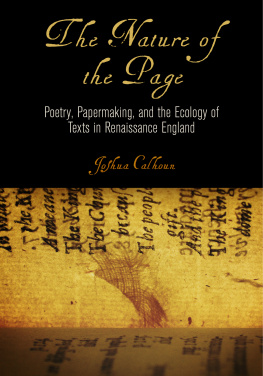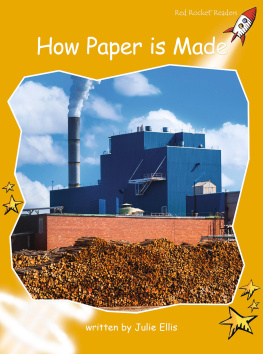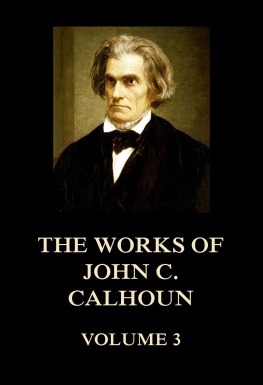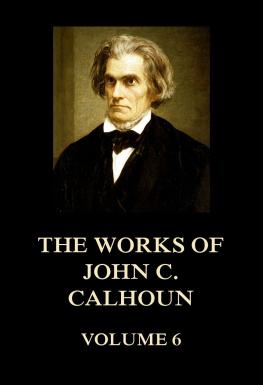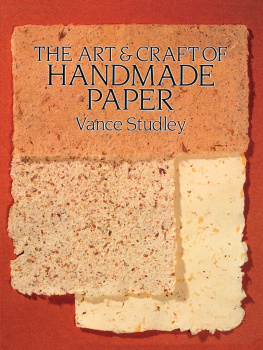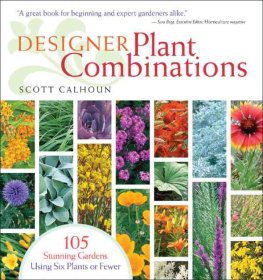Joshua Calhoun - The Nature of the Page: Poetry, Papermaking, and the Ecology of Texts in Renaissance England
Here you can read online Joshua Calhoun - The Nature of the Page: Poetry, Papermaking, and the Ecology of Texts in Renaissance England full text of the book (entire story) in english for free. Download pdf and epub, get meaning, cover and reviews about this ebook. year: 2020, publisher: University of Pennsylvania Press, genre: Art. Description of the work, (preface) as well as reviews are available. Best literature library LitArk.com created for fans of good reading and offers a wide selection of genres:
Romance novel
Science fiction
Adventure
Detective
Science
History
Home and family
Prose
Art
Politics
Computer
Non-fiction
Religion
Business
Children
Humor
Choose a favorite category and find really read worthwhile books. Enjoy immersion in the world of imagination, feel the emotions of the characters or learn something new for yourself, make an fascinating discovery.
- Book:The Nature of the Page: Poetry, Papermaking, and the Ecology of Texts in Renaissance England
- Author:
- Publisher:University of Pennsylvania Press
- Genre:
- Year:2020
- Rating:3 / 5
- Favourites:Add to favourites
- Your mark:
The Nature of the Page: Poetry, Papermaking, and the Ecology of Texts in Renaissance England: summary, description and annotation
We offer to read an annotation, description, summary or preface (depends on what the author of the book "The Nature of the Page: Poetry, Papermaking, and the Ecology of Texts in Renaissance England" wrote himself). If you haven't found the necessary information about the book — write in the comments, we will try to find it.
An innovative study of books and reading that focuses on papermaking in the Renaissance
In The Nature of the Page, Joshua Calhoun tells the story of handmade paper in Renaissance England and beyond. For most of the history of printing, paper was made primarily from recycled rags, so this is a story about using old clothes to tell new stories, about plants used to make clothes, and about plants that frustrated papermakers best attempts to replace scarce natural resources with abundant ones. Because plants, like humans, are susceptible to the ravages of time, it is also a story of corruption and the hope that we can preserve the things we love from decay.
Combining environmental and bibliographical research with deft literary analysis, Calhoun reveals how much we have left to discover in familiar texts. He describes the transformation of plant material into a sheet of paper, details how ecological availability or scarcity influenced literary output in the sixteenth and seventeenth centuries, and examines the impact of the various colors and qualities of paper on early modern reading practices. Through a discussion of sizingthe mixture used to coat the surface of paper so that ink would not blot into its fibershe reveals a surprising textual interaction between animals and readers. He shows how we might read an indistinct stain on the page of an early modern book to better understand the mixed media surfaces on which readers, writers, and printers recorded and revised history. Lastly, Calhoun considers how early modern writers imagined paper decay and how modern scholars grapple with biodeterioration today.
Exploring the poetic interplay between human ideas and the plant, animal, and mineral forms through which they are mediated, The Nature of the Page prompts readers to reconsider the role of the natural world in everything from old books to new smartphones.
Joshua Calhoun: author's other books
Who wrote The Nature of the Page: Poetry, Papermaking, and the Ecology of Texts in Renaissance England? Find out the surname, the name of the author of the book and a list of all author's works by series.

